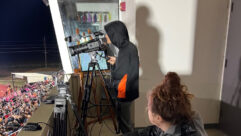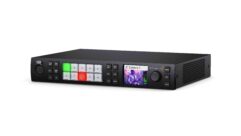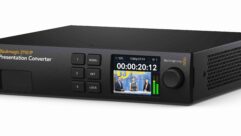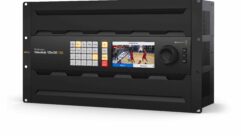

Unspoken Questions About HD
in the AV industry. Everything is moving toward 720p/1080i/1080p resolutions and beyond. But in the commercial space, there are some real issues about hopping on this technology wave. One that few talk about-do we really need HD?
HIGH-DEFINITION VIDEO. IT’S THE LATEST AND GREATEST “V” in the AV industry. Everything is moving toward 720p/1080i/1080p resolutions and beyond—broadcast, video teleconferencing (VTC), presentation displays. The whole industry is preparing for the next generation of video the way it started moving from analog to digital signaling some years back. But in the commercial space, there are some real issues about hopping on this technology wave. One that few talk about—Do we really need HD?A ‘KILLER’ HD APP?WHAT ABOUT CONFERENCING?
As I’ve said before, one of the things I love about the AV industry compared to my previous life in the staunch IT world is its insatiable appetite for the latest and greatest. There are many differences between AV geeks and IT nerds, but the big one that helps drive this appetite is the sheer fact that geeks love stuff that constantly looks and sounds better. Nerds, on the other hand, lust for bigger and faster—network bandwidth, processors, etc. They don’t care all that much about how it looks or sounds.
In the IT world, a law of diminishing returns always seems to kick in. Server processors, for example, get far more powerful than they need to be for the average application server. So what happens? Someone comes up with a “brilliant idea” to take advantage of the extra overhead and it starts all over again. In IT today, virtualization is that brilliant idea—the ability to use a server to host multiple instances of an operating system, thus utilizing normally under-taxed processors to their fullest extent.
But in the professional AV industry, where we’re moving faster and faster toward HD resolutions, what’s the “brilliant idea?” One could argue broadcast HD video is that idea. (Others say not yet.) Yes, we all love HD content on our big screen TVs. I remember my first Sony flat-screen XBR tube TV—a gorgeous picture for sure. Today I rarely flip from the HD channels on my FiOS-fed big screen because for entertainment, SD just isn’t the same.
On the commercial side of the AV industry, I’d argue a similar “killer” HD application may have arrived, but I find myself asking, “Do we really need it?”
I have clients evaluating digital signage who say they want HD video. My first response is always, “Why?” They say, “It looks better.” To which I ask, “Wanna bet?” They’ve seen it at home; they assume it’s true in other applications.
My colleague Mike White of Multi-Media Solutions, told me a story about a recent client who asked him to set up two 42-inch flat-panel displays and show him SD on one and 720p on the other—at 20 feet. After all, in signage applications, few viewers are sitting on a couch at a perfect distance from the screen.
What do you think the result was? That’s right, Mike said the client couldn’t tell the difference. So if that’s the case, how can anyone justify the cost involved in doing HD video content for digital signage? The production costs alone could easily be four times as much as SD production. But it doesn’t stop there.
A decision to do HD video in digital signage has a ripple effect. It starts with the content, of course. Then you need to store it on the head-end content server so it can be sent to the edge players (increased storage costs). Storage may be relatively cheap these days, but next you have to move that content to the edge. That eliminates a handful of technologies right off the bat and usually leaves you with broadband (if it’s an out-of-home network) or high-speed WAN links (for corporate and higher education clients). Connectivity costs tick upwards.
Okay, bandwidth is getting cheaper, too, one could argue. The next ripple, then, is the edge layer. In order to play HD content, you’ll need player hardware far more powerful than what’s required for SD video (higher processing costs). You’ll also need more storage at the edge to hold that HD video—as much as five times that of SD video.
Again, storage is cheap, and the increased computing cost may not be too bad. Analyzing each individual ripple may not sway a client, but add it all up for them and you’ve give a good-size wave that could overwhelm their signage initiative. In reality, the cost of doing HD video in digital signage is prohibitive to all but the deepest-pocketed clients.
And the kicker is, it’s usually not necessary in the first place. A 1360×768 display looks great with that resolution of bitmap images and SD video. We even drive newer, more capable 1920×200 displays at lower resolutions. Why? Again, because the difference is almost imperceptible, why spend the money on the rest of the components?
HD signage may be an unnecessary luxury, but surely videoconferencing is a perfect fit for HD. With the rising costs of travel, the videoconferencing market has significantly expanded. Mix in that pervasive HD broadcasting we’re all growing accustomed to and not surprisingly, clients want better VTC quality. But again, it’s important to quiz your clients to determine if it’s really a necessity.
Telepresence is truly amazing; users feel like they’re right across the table from their colleagues. I’ve even heard from multiple people that meeting members have stood up after a telepresence conference and extended a hand to the other side of the table. That’s powerful stuff, but at a cost for sure. HD systems from Polycom, Tandberg, Life-Size, Hewlett-Packard, Cisco, and others cost as much as 10 times that of non-HD solutions. And the bandwidth required to stage a telepresence call (six streams of HD video for a single point-to-point meeting) can be staggering. Does the customer really need that kind of experience to discuss the latest sales figures? Some may; many don’t.
We’re so enamored by HD video at home that we bring that perception into the workplace. In the home entertainment world, with larger and larger screens, HD is arguably a must. Display technologies like 2K and 4K are revolutionizing the large-screen markets. But in reality, when all the costs are exposed, business use of HD video rarely justifies the expense.
Is that stopping our clients from implementing HD video solutions? Absolutely not. But will college students really notice (or care) that a signage system in the student center is using HD? Will people walking by a digital sign at a train station really notice (or care) if it’s showing HD video? I doubt it. More importantly, will the company (or advertiser or other party) see an actual sales increase because the message is in HD?
As integrators and consultants, we have an obligation to our clients to ask questions when they say simply, “I want HD video.” If there’s no compelling reason, your honesty and expertise may land you the business of installing other solutions paid for by the cost savings. In such a case, just ask, “Why?”
Kris Vollrath is vice president of Advanced AV in West Chester, Pa., an industry consultant, and speaker on digital signage applications and technology.










